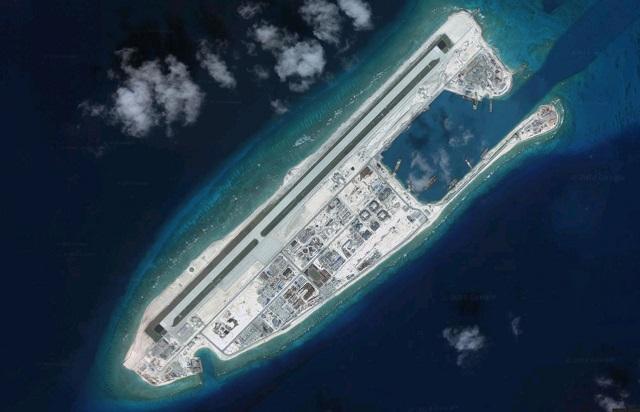A step towards clearer waters? China, ASEAN and the South China Sea
Posted By Huong Le Thu on August 15, 2018 @ 14:39

The announcement [1] earlier this month that ASEAN and China had agreed on a single draft code of conduct negotiating text over the South China Sea after years of talks has been hailed as a milestone [2]. But while getting to that point is evidence of mutual goodwill, it reveals more about the region’s perennial dilemma—how to keep trying when the challenges to cooperation continue to mount.
Given the pace of the negotiations, arriving at the ‘zero draft’ for negotiations sounds like a big achievement. The more sensitive elements up for negotiation though, are wide, starting with the content (a sneak peek here [3]), including the geographic scope; dispute settlement mechanisms; the duty to cooperate; references to the United Nations Convention on the Law of the Sea (UNCLOS); the role of third parties; whether there will be explicit mention of the militarisation activities; and whether it is going to be legally binding—among other contested issues.
There’s disagreement not only between China and ASEAN but also between ASEAN member states. Stalled negotiations have led many commentators, including me [4], to conclude that the code of conduct could become a tool in China’s strategy to distract the rival claimants with detrimental consequences for ASEAN’s interests. The long-running ASEAN–China dialogue on the South China Sea has brought little confidence because of concerns about China’s intentions and ASEAN’s ability to reconcile its internal divisions.
But the single draft suggests that there’s some symbolic value behind the largely questionable ‘progress’. China’s leaders want to show that they’re capable of resolving the disputes peacefully. A conciliatory attitude will also help guard against meddling by ‘external parties’ as Beijing demonstrates that it can manage issues with neighbours smoothly. Not only are the talks ‘back on track’, but China is offering more cooperation, including announcing the first-ever China–ASEAN maritime exercises [5]. Scheduled to take place in October, ahead of the ASEAN summit in November, the joint initiative is certainly a positive sign for regional cooperation.
Beijing’s good intentions are also being demonstrated beyond Southeast Asia. China has donated a warship to Sri Lanka and pledged [6] a ‘surveillance and hydrographic’ vessel to Fiji later this year. It’s important for Beijing to show that it can ‘cooperate’. However, negotiating a peaceful settlement of disputes seems detached from China’s steady militarisation of the artificial islands it has constructed in the South China Sea and its incremental control over the disputed waters. Coercive behaviour towards vessels [7] or aircraft passing through or over the area continues.
So why do the ASEAN states play along? Despite the challenges of the process and the many concerns that Southeast Asian nations have about China, none of them can afford to disengage. While the majority of the Filipino [8] population still strongly support their country’s assertion of its maritime claims, the (still popular) Duterte administration has opted for some risky bets in its relations with Beijing. Most recently, the foreign secretary, Alan Peter Cayetano, said [9] that Manila’s willingness to ‘put aside territorial claims’ in pursuit of joint exploration with Beijing was ‘a matter of principled pragmatism’. ‘[L]et’s cooperate first, and let’s talk about who owns what, who has jurisdiction, later on’, he said, adding, ‘What’s better, 60-40 or 0-0?’ Many Filipino experts find Manila’s new attitude hard to accept [10].
Singapore—this year’s ASEAN chair—is under pressure to deliver [11]. It has just completed its term as the coordinator of the ASEAN–China dialogue and appears to have wanted to lock in the list of items to be included for further negotiations. As one example, the draft negotiating text includes China’s proposal that parties ‘not hold joint military exercises with countries from outside the region, unless the parties concerned are notified beforehand and express no objection’. If that clause makes it into the final, it would give Beijing a veto over ASEAN member states’ choices about who they conduct exercises with in the South China Sea.
It’s no surprise that Beijing is seeking to impose unfavourable conditions on the rest of the claimants. But where the negotiations go from here, and whether they will be binding, is another matter. As such, the draft’s real value is that it changes the nature of the negotiations to ‘open cards’ and enhances the transparency of the process.
Timing is an important factor given the ASEAN tradition of rotational leadership. The Philippines assumed coordinatorship of the ASEAN–China dialogue on 5 August [12] and will serve in the role until 2021. The Duterte government has, as yet, displayed little evidence of its ability to represent ASEAN-wide interests in the negotiations with China.
While finalising the code of conduct is still a remote prospect, the next few years will determine the momentum and nature of the negotiations. A non-claimant as the next ASEAN chair would add to neutrality of the negotiations (next year is Thailand’s turn). The year 2020 may bring more interesting developments: Vietnam—an active claimant—will become chair and intends [13] to have a strong focus on security, including deepening the agenda for the ASEAN Defence Ministers Meeting Plus forum. In the following years, the chairing will successively rotate to Brunei, Cambodia and Laos.
All ASEAN member states—both claimants and non-claimants—are interested in engaging with China, and the single draft negotiating text is a sign of progress. But challenging times are ahead for the claimant states to negotiate provisions that actually support rather than circumvent UNCLOS, including the option for judicial settlement and arbitration in case of further violations.
Article printed from The Strategist: https://aspistrategist.ru
URL to article: /a-step-towards-clearer-waters-china-asean-and-the-south-china-sea/
URLs in this post:
[1] announcement: http://asean.org/storage/2018/08/51st-AMM-Joint-Communique-Final.pdf
[2] milestone: https://www.reuters.com/article/asean-singapore-southchinasea/asean-china-agree-milestone-text-as-basis-for-south-china-sea-talks-idUSL4N1UT3FL
[3] here: https://thediplomat.com/2018/08/a-closer-look-at-the-asean-china-single-draft-south-china-sea-code-of-conduct/
[4] including me: https://amti.csis.org/the-dangerous-quest-for-a-code-of-conduct-in-the-south-china-sea/
[5] maritime exercises: https://www.channelnewsasia.com/news/first-asean-china-maritime-exercise-training-navy-mindef-10586432
[6] pledged: https://thediplomat.com/2018/07/china-to-gift-hydrographic-and-surveillance-vessel-to-fiji/
[7] vessels: http://www.gmanetwork.com/news/news/nation/664008/patrols-in-disputed-waters-warned-by-chinese-on-daily-basis-afp/story/
[8] majority of the Filipino: http://globalnation.inquirer.net/168371/73-filipinos-want-duterte-admin-assert-rights-west-philippine-sea
[9] said: https://www.rappler.com/nation/209043-philippines-to-put-aside-rights-joint-development-china
[10] hard to accept: https://adrinstitute.org/2018/07/12/remarks-of-amb-albert-del-rosario-chinas-grand-larnecy/amp/?__twitter_impression=true
[11] pressure to deliver: /singapores-asean-chairmanship-high-expectations-high-achiever/
[12] on 5 August: http://www.pna.gov.ph/articles/1043786
[13] intends: https://www.iiss.org/-/media/images/dialogues/sld/sld-2018/documents/ngo-xuan-lich-sld18.ashx?la=en&hash=A2D3B8333EAE05719DBC3ED36AFA0BDBDB7B2B2A
Click here to print.